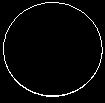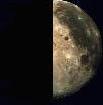 |
 |
 |
 |
December has two major meteor showers, the Geminids and the Ursids.
The annual Geminid meteor shower will peak on the night of December 14th. This shower is often one of the better showers since as many as 100 meteors per hour may be seen. This is an unusual shower in that the source of the shower is not believed to be a comet, but rather from an object known as 3200 Phaethon. This object is currently classified as an asteroid, but some scientists believe that it might be an extinct comet with a thick crust of interplanetary dust.
Another thing that makes the Geminids unusual is that one doesn't have to wait until after midnight to catch this shower. The radiant rises early and meteors can be seen around 10:00 PM local time, but the best view will still be after midnight local time. This shower also boasts a broad maximum, lasting nearly one whole day, so usually no matter where you live, you stand a decent chance of catching sight of some Geminids. Fortunately, the 33% illuminated Moon rises about 1 AM and will obscure only the dimmest of the Geminids in 2006
The Ursids peak on December 22 and have a peak hourly rate of 10 or so, but in some years the hourly peak has risen as high as 50. The Moon will not offer any interference this year, so 2006 is a great year to try to catch some Ursids.
I have created a low volume email list for advance notification of upcoming meteor showers and unusual astronomical events; especially those that can be observed with the unaided eye, binoculars, or a small telescope. To join, simply enter your email address below and click on the join now button.
 |
 |
 |
 |
Return to Meteor Showers in 2006-2007
Return to Celestial Wanderings
Send me e-mail StarWanderer